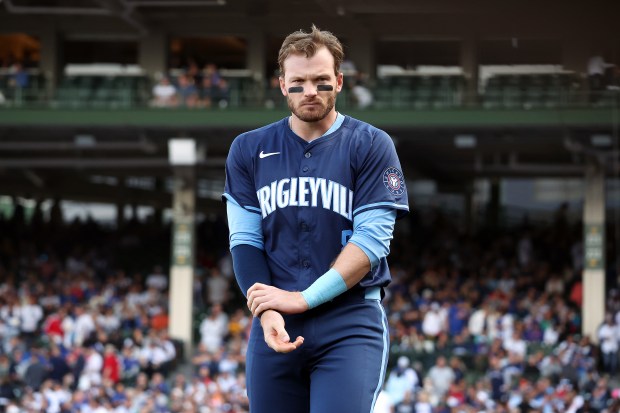LOS ANGELES — There are stretches when the Chicago Cubs lineup’s production makes it a top-10 offense in the majors.
But the Cubs have endured just as many confounding periods of offensive futility, most notably a crushing May and June, that present challenging questions the organization must answer this offseason.
Namely, why are these vast inconsistencies happening and how do the Cubs avoid such extreme outcomes in 2025?
“It’s a complicated season to figure out an offensive standpoint. That is true,” president of baseball operations Jed Hoyer said Friday at Wrigley Field. “We’ve had these explosions recently, we had a really good April and we struggled tremendously mightily for two months. (Wrigley) makes it that much more confusing to figure out.
“We’ve had these ups and downs during the course of the year, and then big ups and big downs, which has been difficult to reconcile intellectually.”
The Cubs’ offensive numbers at Wrigley and on the road depict two different teams. They have been a bottom-third offense at home, ranking tied for 24th in weighted runs created plus (93), 26th in home runs (69), 27th in weighted on-base average (.295) and 28th in batting average (.224).
Conversely, in road games, the Cubs entered Monday night’s series opener at Dodger Stadium ninth in average (.251), tied for ninth in wRC+ (105) and wOBA (.321) and tied for 12th in home runs (80).
“Some of that is quite randomness and some of that is probably the fact that the wind’s blowing in virtually every day this year, and we have to take all those things into account,” Hoyer said. “I don’t think you can really take all those things into account until the season’s over and we can really make those adjustments.
“I do wonder sometimes how much that was the weather. How many games we played last year, it felt like the explosions we had last year were at home. I think of an awesome series we had in August where the ball is flying all over the place. … Trying to figure out what that means for our offense going forward, it’s a very complicated thing to try to figure out because I don’t think it’s that obvious.”
If the Cubs determine they have a personnel issue that makes them susceptible to extreme offensive outputs, the path to rectifying that wouldn’t be easy. Their lineup is largely in place to return next year.
Seiya Suzuki, Ian Happ, Nico Hoerner and Dansby Swanson all have at least two years left on their contracts, with Suzuki and Happ holding full no-trade clauses through the length of their deals, which end after the 2026 season.
Despite his struggles, the Cubs acquired third baseman Isaac Paredes with the belief he would be a valuable piece of their lineup while under team control through three more years of arbitration. Michael Busch has lived up to expectations at first base in his first full big-league season.
Pete Crow-Armstrong has shown he is the center fielder of the future. His offensive turnaround and Miguel Amaya emerging as the hitter the Cubs believe he can be carry short- and long-term consequences.
“We don’t have the player in the middle of the lineup that’s a six, seven, eight (wins above replacement) player, and so we have to rely on balance more than that consolidation of WAR,” Hoyer said. “And for a while we didn’t have the consolidation of WAR and we didn’t have the balance and we saw the results of that.
“Now we’re seeing the results, at least having the balance where we can score any inning, and it makes a big difference.”
The wild card is Cody Bellinger, who has a $27.5 million player option for 2025. Even if he stays, however, the Cubs likely need to shake things up and bring in another proven hitter. The options of whom they would move and the available sluggers with a big-league track record could make that a challenging balance to obtain.
“Last year was something we can’t repeat type of thing,” Hoyer said, “and obviously we’re kind of doing that again, so it does make it that much more difficult to reconcile and we’ll have to figure that out.”
Hoyer pointed to the lack of MVP-caliber offensive production from any of their hitters, unlike what they saw from Bellinger last year when he carried the Cubs for stretches.
“This year we have a lot of balance, we have a lot of players having solid years now that they’ve come out of their May and June,” Hoyer said. “But we don’t have anyone doing that. That is a difference between last year and this year.”
With the Cubs heading toward their fourth consecutive season without making the playoffs — a drought that dates to 2018 for a full 162-game season — assessing the offensive issues and course-correcting represents a challenge for the offseason and the organization’s future direction.
“We have to own the fact that we were also the May and June Cubs, and then we’re also this group,” Hoyer said. “I don’t think you can just take the good and eliminate the bad. You have to take it all and analyze it and make those decisions.”



